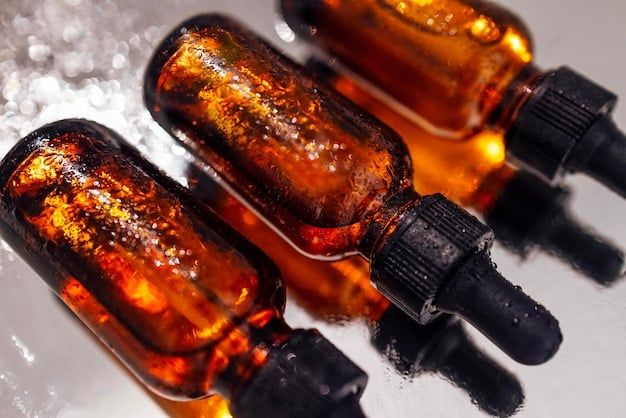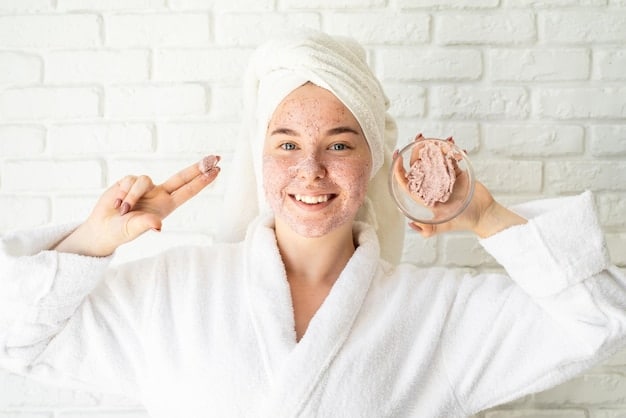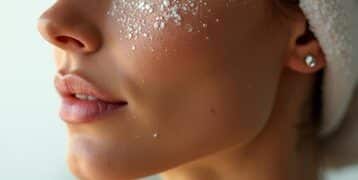Exfoliation Power: Reveal a Brighter Complexion with This Guide

Achieving a brighter complexion through exfoliation involves understanding the various methods and their benefits, effectively removing dead skin cells to promote cell turnover and enhance skin radiance.
Dull, lifeless skin can often feel like an inevitable part of life, but what if there was a simple yet profound secret to unlocking a luminous, healthy glow? Enter the remarkable world of exfoliation. Understanding The Power of Exfoliation: How to Remove Dead Skin Cells and Reveal a Brighter Complexion isn’t just about skincare; it’s about rejuvenating your appearance from the cellular level, bringing forth a freshness that radiates health and vitality.
Understanding the Science of Skin Renewal
Our skin is an incredible organ, constantly working to protect us from the outside world. Part of this perpetual process involves constant renewal, where new skin cells are generated in the deeper layers and gradually migrate to the surface. As they reach the outermost layer, the stratum corneum, these cells flatten and eventually die, forming a protective barrier. While this natural shedding process is essential, it isn’t always efficient. Dead skin cells can accumulate, leading to a dull, rough, and uneven complexion.
This accumulation can also clog pores, contributing to breakouts and preventing skincare products from penetrating effectively. Exfoliation intervenes in this natural cycle, assisting the skin in shedding these old, dead cells more efficiently. By doing so, it reveals the fresher, newer cells beneath, which are more vibrant and capable of reflecting light evenly, thus promoting a brighter, more youthful appearance. The science behind this is straightforward: a smoother surface reflects light better, contributing to that coveted glow.
The Role of Cell Turnover
Cell turnover is the rate at which skin cells are produced and rise to the surface. In younger skin, this process is generally swift, occurring approximately every 28 days. However, as we age, this rate slows dramatically, often stretching to 40 days or more. This slowdown is a primary reason why older skin tends to look duller and rougher, as dead cells linger longer on the surface.
- Increased Radiance: By removing dead cells, exfoliation instantly brightens the skin.
- Improved Texture: It smooths out rough patches and makes the skin feel softer.
- Enhanced Product Absorption: Skincare ingredients can penetrate deeper and work more effectively.
- Reduced Breakouts: Unclogging pores helps prevent acne and blackheads.
Moreover, consistent exfoliation can stimulate collagen production over time, which further contributes to skin plumpness and elasticity, reducing the appearance of fine lines and wrinkles. It’s a foundational step in skincare for anyone looking to maintain a healthy, vibrant complexion, regardless of age or skin type. However, understanding the different types of exfoliation is crucial to choose the right method for your specific skin needs.
Physical Exfoliation: Methods and Benefits
Physical exfoliation, often referred to as mechanical exfoliation, involves using abrasive materials or tools to manually remove dead skin cells from the skin’s surface. This can range from granular scrubs to brushes and cloths. The immediate gratification aspect of physical exfoliation – the sensation of removing rough patches and revealing smoother skin – makes it a popular choice for many. However, moderation and proper technique are absolutely essential to avoid irritation and micro-tears.
When selecting a physical exfoliant, the size and shape of the abrasive particles are key. Scrubs with fine, spherical beads are generally preferred over those with jagged particles, like crushed nut shells or fruit pits, which can cause microscopic damage to the skin barrier. The goal is gentle sloughing, not aggressive scrubbing.
Popular Physical Exfoliation Methods
There are several tried-and-true methods for physical exfoliation, each with its own set of advantages:
- Facial Scrubs: These contain small particles that manually buff away dead skin. Look for scrubs with smooth, non-irritating grains.
- Exfoliating Brushes: Devices like sonic cleansing brushes use oscillating or rotating bristles to deeply cleanse and exfoliate.
- Konjac Sponges: Made from the konjac plant, these soft, porous sponges can be used daily for a very gentle exfoliation.
- Microfiber Cloths: Simply using a damp, warm microfiber cloth in gentle circular motions can provide light exfoliation.
While physical exfoliation offers immediate results, it’s important to pay attention to your skin’s reaction. Over-exfoliation can lead to redness, sensitivity, and even compromised skin barrier function. For most skin types, using a physical exfoliant 1-2 times a week is sufficient. Individuals with sensitive skin might opt for less frequent use or choose super-gentle options like konjac sponges. Always follow up with a moisturizer to soothe and protect the newly exposed skin.
Chemical Exfoliation: Acids and Enzymes for Smooth Skin
Chemical exfoliation offers a different approach to shedding dead skin cells, utilizing acids or enzymes to dissolve the bonds holding them together on the skin’s surface. Unlike physical exfoliants, which rely on friction, chemical exfoliants work at a molecular level, providing a more even and often deeper exfoliation without the need for manual scrubbing. This method is particularly beneficial for those with sensitive skin, acne, or concerns about uneven skin tone and texture, as it tends to be less irritating when properly used.
The two main categories of chemical exfoliants are Alpha Hydroxy Acids (AHAs) and Beta Hydroxy Acids (BHAs), along with various fruit enzymes. Each has unique properties that cater to different skin needs, making it essential to understand their distinctions to choose the most effective option.
Alpha Hydroxy Acids (AHAs)
AHAs are water-soluble acids derived from sugary fruits. They work primarily on the skin’s surface, breaking down the glue that holds dead skin cells together. This allows for easier shedding, revealing smoother, brighter skin. AHAs are excellent for addressing surface-level concerns. Common AHAs include:
- Glycolic Acid: Derived from sugar cane, it’s the smallest AHA, allowing it to penetrate deeply. Great for uneven tone, fine lines, and sun damage.
- Lactic Acid: Derived from milk, it’s gentler than glycolic acid and also provides hydration, making it suitable for drier or more sensitive skin.
- Mandelic Acid: From bitter almonds, it has a larger molecular size, meaning it penetrates slower and is very mild, ideal for very sensitive or acne-prone skin.
Beta Hydroxy Acids (BHAs)
BHAs are oil-soluble, which means they can penetrate oil and therefore dive deeper into the pores. This makes them particularly effective for oily and acne-prone skin, as they can dissolve sebum and dead skin cells that clog pores. The most common BHA is salicylic acid.
Salicylic Acid: Derived from willow bark, it’s a potent anti-inflammatory and antibacterial agent, making it highly effective for treating blackheads, whiteheads, and acne breakouts. Its oil-soluble nature allows it to work within the pore lining, preventing future clogs.
Enzymes, often sourced from fruits like papaya (papain) and pineapple (bromelain), offer a milder form of chemical exfoliation. They selectively digest dead skin cells without affecting living ones, making them a good option for highly sensitive skin or those looking for very gentle brightening without irritation. When choosing a chemical exfoliant, start with lower concentrations and gradually increase frequency as your skin adjusts. Always use sunscreen, as chemical exfoliants can increase sun sensitivity.

Choosing the Right Exfoliation Method for Your Skin Type
The vast world of exfoliation offers many pathways to radiant skin, but the key to success lies in matching the method to your unique skin type and concerns. What works wonders for one person might cause irritation for another. Understanding your skin’s needs is the first step toward unlocking its full potential without compromising its health and barrier function.
It’s crucial to remember that your skin type can change over time due to factors like age, hormones, climate, and lifestyle. What was once effective might need adjustment, and listening to your skin is paramount. Always introduce new exfoliation methods gradually, starting with lower concentrations or less frequent use, and observe how your skin responds.
Guidelines for Different Skin Types
- Oily Skin: This skin type often tolerates more frequent and stronger exfoliation. BHAs (like salicylic acid) are excellent for their oil-soluble properties, deeply cleansing pores and preventing breakouts. Physical scrubs with fine grains can also be beneficial, used 2-3 times a week.
- Dry Skin: Dry skin benefits from gentle exfoliation to remove flakes and allow moisturizers to penetrate better. AHAs, especially lactic acid, are ideal as they also offer hydration. Avoid harsh physical scrubs, which can strip natural oils. Exfoliate 1-2 times a week.
- Sensitive Skin: This skin type requires the utmost care. Opt for mild enzymes or very low concentrations of AHAs (like mandelic acid or polyhydroxy acids, PHAs). Avoid physical scrubs altogether or use ultra-gentle options like konjac sponges very sparingly. Patch testing is essential, and exfoliate no more than once a week.
- Combination Skin: This challenging skin type may require a targeted approach. You might use a BHA in oily areas (T-zone) and a gentler AHA or enzyme in drier areas (cheeks). Alternatively, a mild overall AHA or enzyme exfoliant 1-2 times a week can be effective.
- Acne-Prone Skin: BHAs (salicylic acid) are almost always the go-to for acne due to their ability to penetrate oil and clear pores. Glycolic acid can also help with post-inflammatory hyperpigmentation. Avoid abrasive physical scrubs, which can spread bacteria and worsen inflammation.
- Mature Skin: As cell turnover slows with age, exfoliation becomes increasingly important. AHAs (glycolic or lactic acid) are excellent for addressing fine lines, uneven tone, and promoting collagen production. Enzymes are also a good, gentle option.
Regardless of your skin type, always follow exfoliation with a hydrating serum and a good moisturizer to restore the skin barrier. And, critically, never skip daily broad-spectrum sunscreen, as freshly exfoliated skin is more susceptible to sun damage.
Best Practices for Effective and Safe Exfoliation
Exfoliation, when done correctly, is a cornerstone of a healthy and effective skincare routine. However, like any powerful treatment, it comes with a set of rules to ensure maximum benefits and minimize risks. Over-exfoliation is a common pitfall that can lead to irritation, redness, compromised skin barrier, and increased sensitivity. Adhering to best practices is not just about avoiding problems; it’s about optimizing the results, ensuring that your skin truly glows from within.
The goal is to gently assist your skin’s natural renewal process, not to strip it or cause trauma. This delicate balance requires attention to product selection, application technique, frequency, and post-exfoliation care. Considering your current skin condition, the climate, and even other active ingredients in your routine will help you tailor your exfoliation regimen for optimal safety and efficacy.
Key Practices for Optimal Exfoliation
- Start Gradually: Whether you’re new to exfoliation or trying a new product, begin with a lower frequency (e.g., once a week) and a milder concentration. Slowly increase as your skin adapts.
- Read the Labels: Understand the active ingredients and their concentrations. Products with high percentages of acids might be meant for occasional use, while gentler formulations could be suitable for more frequent application.
- Patch Test: Before applying a new exfoliant to your entire face, test a small amount on an inconspicuous area, like behind your ear or on your forearm, to check for adverse reactions.
- Don’t Overdo It: More is not better when it comes to exfoliation. Excessive scrubbing or too frequent use of chemical exfoliants can disrupt the skin’s natural barrier, leading to dryness, redness, and increased sensitivity.
- Gentle Application: For physical exfoliants, use light, circular motions. For chemical exfoliants, simply apply with clean hands or a cotton pad and let the product work. Avoid harsh rubbing.
- Factor in Other Products: Be mindful of combining exfoliants with other active ingredients like retinoids or vitamin C. This can lead to increased sensitivity. Consult a dermatologist if unsure.
- Always Moisturize: Exfoliation can temporarily make your skin more vulnerable. Immediately follow up with a hydrating serum and a rich moisturizer to replenish moisture and support the skin barrier.
- Sun Protection is Non-Negotiable: Exfoliated skin is more susceptible to sun damage. Always apply a broad-spectrum sunscreen with at least SPF 30 every morning, even on cloudy days.
By integrating these practices into your routine, you can safely harness the power of exfoliation to achieve a clearer, smoother, and more radiant complexion without compromising your skin’s health.

Addressing Common Exfoliation Myths and Misconceptions
The world of skincare is rife with information, and unfortunately, misinformation. Exfoliation, being a popular yet powerful step, is particularly prone to myths and misconceptions that can lead to ineffective practices or even harm. Separating fact from fiction is critical for anyone looking to safely and effectively incorporate exfoliation into their routine and truly benefit from its brightening and skin-renewing properties.
From the belief that stinging indicates effectiveness to fears about thinning skin, these misconceptions can deter individuals from proper exfoliation or push them towards practices that are counterproductive. Understanding the science and debunking these common myths will empower you to make informed decisions for your skin’s health.
Debunking Exfoliation Myths
Let’s tackle some of the most prevalent misunderstandings about exfoliation:
- Myth: If it stings, it’s working.
Fact: While some mild tingling can occur with active ingredients, a strong stinging or burning sensation is a sign of irritation. This indicates that the product might be too harsh for your skin, you’re using it too frequently, or you’re combining it with other reactive ingredients. Prolonged stinging can lead to a damaged skin barrier, redness, and increased sensitivity.
- Myth: You should exfoliate every day.
Fact: Daily exfoliation is typically too much for most skin types, especially if using strong products. Over-exfoliation can strip the skin of its natural oils, compromise its protective barrier, and lead to dryness, redness, sensitivity, and even breakouts. For most people, 1-3 times a week is sufficient, depending on the product strength and skin type.
- Myth: Physical exfoliation is always bad for your skin.
Fact: This is an oversimplification. While harsh physical scrubs with jagged particles can cause micro-tears, gentle physical exfoliants (like scrubs with fine, rounded beads, konjac sponges, or soft muslin cloths) can be very effective and safe for many skin types when used correctly and in moderation.
- Myth: Exfoliation thins your skin.
Fact: This is incorrect. Exfoliation actually encourages cell turnover, promoting the growth of new, healthy skin cells. Over time, consistent, gentle exfoliation can even stimulate collagen production, which helps make the skin appear plumper and thicker, not thinner. What it does do is remove the outer layer of dead cells, making the skin *appear* more delicate for a short period, which is why sun protection is crucial.
- Myth: People with sensitive skin should never exfoliate.
Fact: Even sensitive skin benefits from gentle exfoliation to remove dead cells and improve texture. The key is choosing the right method and product. Mild enzymes, polyhydroxy acids (PHAs), or very low concentrations of AHAs like mandelic acid are excellent options. It’s about careful selection and minimal frequency, not complete avoidance.
By dispelling these common myths, you can approach exfoliation with greater confidence and make choices that genuinely support your skin’s health and radiance.
Integrating Exfoliation into Your Skincare Routine
Once you understand the ‘what’ and ‘why’ of exfoliation, the next crucial step is seamlessly weaving it into your daily and weekly skincare regimen. Exfoliation isn’t a standalone act; it’s a complementary step that enhances the efficacy of other products and treatments. A well-integrated routine ensures that your skin receives the full benefits of exfoliation without experiencing any adverse effects, leading to a consistently brighter, smoother, and healthier complexion.
The order in which you apply your skincare products matters, and exfoliation plays a specific role within this sequence. Generally, exfoliation should occur after cleansing and before toning and treating. This ensures that dead skin cells and impurities are removed, allowing subsequent products to penetrate deeper and work more effectively.
A Step-by-Step Guide for Integration
Consider the following sequence for incorporating exfoliation:
- Morning or Evening?
Most dermatologists recommend exfoliating in the evening. This allows your skin to recover overnight and minimizes immediate sun exposure post-exfoliation when skin might be more sensitive. If you exfoliate in the morning, strict sunscreen application is non-negotiable.
- Cleanse First:
Always start with a clean face. Use a gentle cleanser to remove makeup, dirt, and surface oils. This prepares your skin for exfoliation by ensuring the active ingredients or physical particles can work directly on the skin cells, not on a layer of grime.
- Apply Exfoliant:
If using a physical scrub, apply a small amount to damp skin and gently massage in circular motions for 30-60 seconds. Rinse thoroughly. For chemical exfoliants (toners, serums, or masks), apply to clean, dry skin as directed. Leave-on products should be allowed to absorb. Rinse-off masks should be removed after the specified time.
- Tone (Optional):
If you use a toner, apply it after exfoliation and before serums. Non-exfoliating, hydrating toners can help balance the skin’s pH and prepare it for subsequent steps.
- Serums and Treatments:
This is when your serums (e.g., hyaluronic acid, vitamin C, niacinamide) and targeted treatments should be applied. With dead skin cells removed, these potent ingredients can penetrate more effectively and deliver better results.
- Moisturize and Protect:
Always finish with a good moisturizer to hydrate and seal in moisture, supporting the skin’s barrier function. In the morning, follow with a broad-spectrum sunscreen of at least SPF 30. This final step is paramount, especially after exfoliation, to protect newly exposed skin from environmental damage.
Consistency is key, but so is moderation. Pay attention to your skin’s signals. If you notice signs of irritation, reduce the frequency or switch to a milder product. A well-integrated exfoliation routine will transform your skin, revealing its natural luminosity and enhancing its overall health.
| Key Point | Brief Description |
|---|---|
| ✨ Skin Renewal | Removes dead cells, boosts radiance & texture by promoting cell turnover. |
| 🔬 Chemical Exfoliating | Uses acids (AHAs/BHAs) or enzymes to dissolve dead skin, suitable for targeted concerns. |
| ✋ Physical Exfoliating | Employs scrubs or tools for manual removal. Requires gentle technique to avoid irritation. |
| ✅ Best Practices | Start slowly, moisturize, and always use sunscreen post-exfoliation for safety. |
Frequently Asked Questions About Exfoliation
The ideal frequency depends on your skin type and the exfoliant’s strength. Generally, 1 to 3 times a week is recommended for most. Sensitive skin may only tolerate once a week, while oily skin might handle up to three. Always listen to your skin and reduce frequency if irritation occurs.
Yes, exfoliation can be very beneficial for acne-prone skin, especially with chemical exfoliants like salicylic acid (a BHA). These can penetrate oil to unclog pores and reduce breakouts. However, avoid harsh physical scrubs that can irritate active acne or spread bacteria.
Physical exfoliation uses friction (scrubs, brushes) to manually remove dead cells. Chemical exfoliation uses acids (AHAs, BHAs) or enzymes to dissolve the bonds holding dead cells together. Chemical methods tend to be more even and gentler for many skin types if chosen correctly.
Yes, freshly exfoliated skin has had its protective top layer of dead cells removed, making it more vulnerable to UV radiation. It is absolutely crucial to apply a broad-spectrum sunscreen with an SPF of at least 30 every morning, especially after exfoliating, to prevent sun damage.
No, it’s generally not recommended to use multiple types of exfoliants (e.g., a physical scrub and an AHA serum) at the same time or too close together. This can easily lead to over-exfoliation, causing irritation, redness, and damage to the skin barrier. Stick to one method at a time, allowing your skin to recover.
Conclusion
Embracing the power of exfoliation is a transformative step towards achieving a brighter, healthier complexion. By understanding the science of skin renewal, choosing the right method for your skin type, and adhering to best practices, you can effectively remove dead skin cells and reveal the luminous skin beneath. This process not only enhances your skin’s radiance and texture but also optimizes the efficacy of your entire skincare routine. Remember, consistency, gentleness, and sun protection are the pillars of successful exfoliation, paving the way for a truly vibrant and youthful glow.





